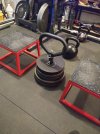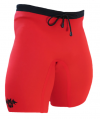Hey Bill, how do you find the different angles for pullups? I've often wondered how comfortable this type of bar is to use, since you are stuck using a certain width if you want a certain angle, if that makes sense.
I gone over to using free-rotating grips for all my pullups.
I have the Angles90 grips and the Abmat 1/4 rings. Both of these are free-rotating, like rings.
I don't much like the Angles90. They're more fiddly to set up, and I don't find the grip to be particularly comfortable even though they're intended to have an ergonomic shape. In most configurations I find that the strap chafes my fingers uncomfortably somewhere.
I love the Abmat 1/4 rings. For pullups, the advantage over full rings is that they set up close to the bar and don't hang down as far, which makes a big difference when your bar is limited in height (mine is part of my power rack) and you have limited ceiling clearance.
Here's my N=1 experience using these grips:
I've always been stronger in chin ups than in pull ups, which seems common. But I mainly did pull ups because harder is better, right? Chin ups felt like cheating. At one point I trained pull ups up to a double at BW+90lbs, and a single at BW+110lbs. But I did suffer from some chronic golfer's elbow whenever I trained pull ups, which was very persistent, even after long layoffs.
After a couple of rotator cuff surgeries (one on each side, due to acute injuries while playing basketball), I didn't train pull ups or chins ups for several years. Whenever I tried them I was very weak and my external rotation, especially on one side, was not good. So pull ups were uncomfortable.
Earlier this year, I decided try training pull ups again, and I got a set of Angles90 grips, and then a pair of Abmat 1/4 rings, to do ring pull ups in the hopes that they would be more comfortable for my shoulder and less likely to cause a recurrence of golfer's elbow.
This experiment has been a great success so far. Pull ups on the rings feel very comfortable, strong, and natural, and I've had no elbow problems. I am now routinely doing sets of 5 with BW+25lbs. I have the 1/4 rings set relatively narrow and they hang about 6.5 inches below the bar. I pull until the front of my chin below my lip touches the bar and the palms of my hands are about nipple level.
I saw a recent thread here on the forum where someone was asking about how to be stronger in the top of the pull up and get the bar to the neck or chest. Out of curiosity I decided to try a regular pull up to see how it felt. To my surprise, I nearly launched myself through the ceiling. My top position was much higher and easier to get to than it ever was when I was actually training pull ups, even with a lot more added weight.
BTW, I've always found the idea of "tactical" pull ups to be somewhat silly, certainly for my needs. First, it's an exercise, not wall-scaling practice. In scaling a wall, there probably isn't any bar to grip at all (thumbless grip or not), you probably can't hang below the bar in a hollow position with your legs extended in front of you, and you probably can use your legs against the wall. The difference between a tactical pull up and scaling a wall is arguably bigger than the difference between a tactical pull up and a chin up (not that I'm really interested in starting an argument about it). Second, I have essentially zero need to ever scale a wall. I have no specific memory of the last time I had to do it. Third, since I find ring pull ups so much more natural and comfortable, and I have been completely injury-free since starting to do them, there is little reason to do a variation that has caused elbow problems for me in the past. Fourth, my recent experience suggests that I would get better carryover from ring pull ups to wall-scaling anyway, assuming I had any need to scale walls at all.


